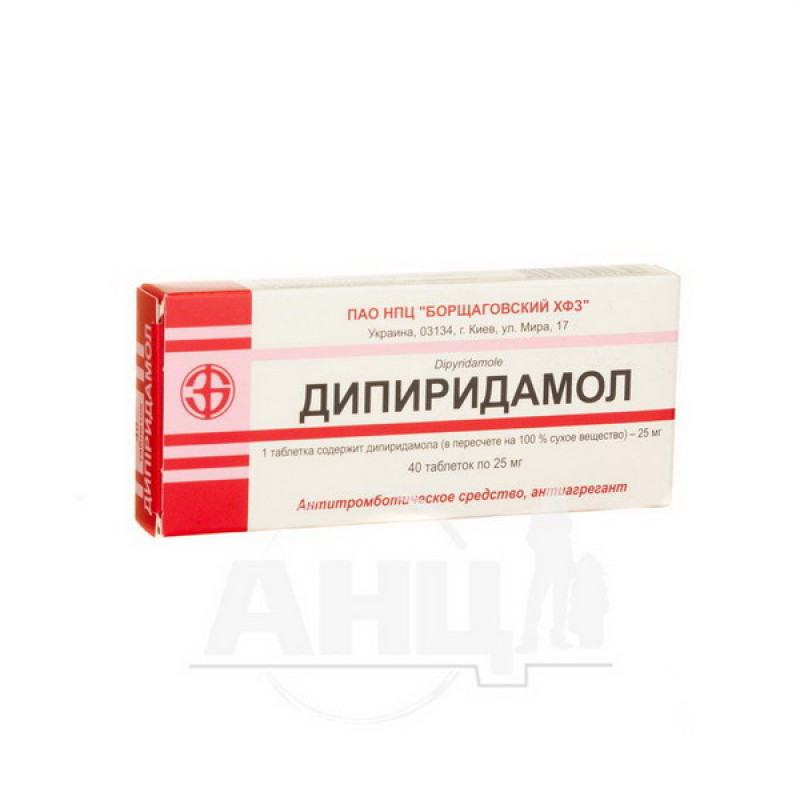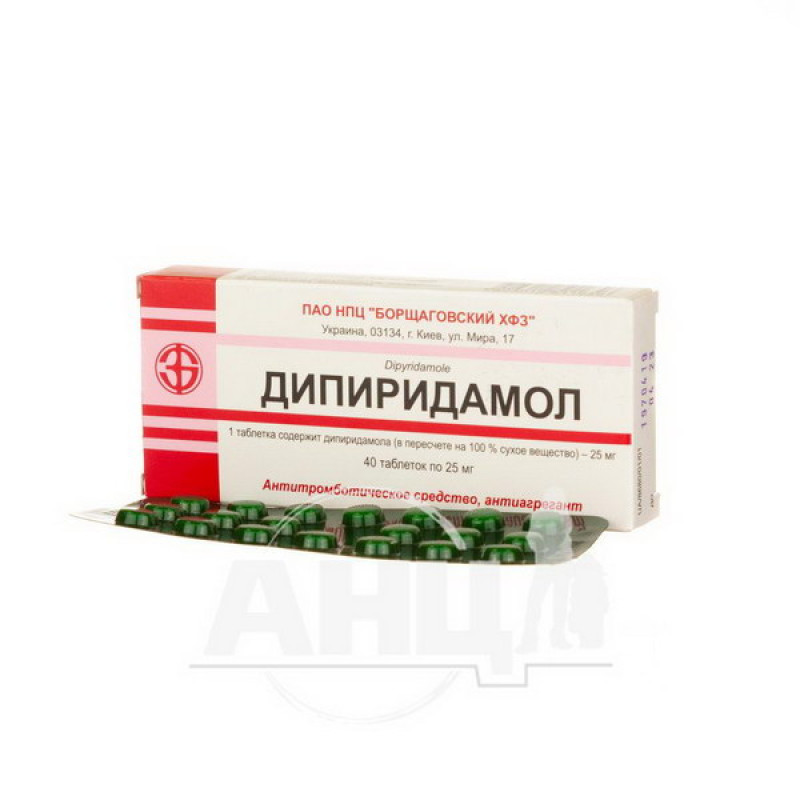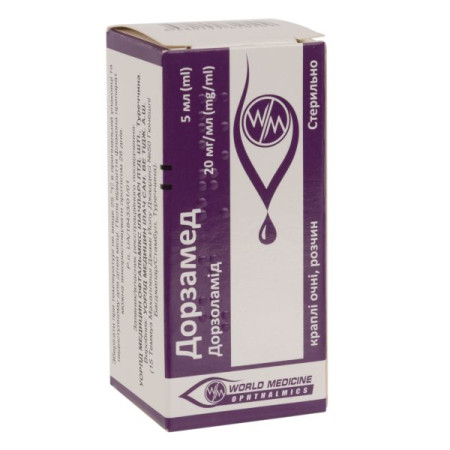Dipyridamole tablets 25 mg blister No. 40

Translation of the instructions can be
Dipyridamole tablets 25 mgInstruction
For medical use of the medicinal product
Composition:
Active ingredient: dipyridamole;
1 tablet contains dipyridamole (calculated as 100% dry matter) - 25 mg;
excipients: potato starch, lactose monohydrate, calcium stearate.
Dosage form.
Pills.
Main physicochemical properties: round tablets with a biconvex surface of yellow with a greenish tint.
Pharmacotherapeutic group.
Antithrombotic agents. antiplatelet agents. dipyridamole. ATC code B01A C07.
Pharmacological properties.
Pharmacodynamics.
Dipyridamole dilates coronary vessels, increases the volumetric velocity of coronary blood flow, improves the supply of oxygen to the myocardium, increases its resistance to hypoxia. Promotes improvement of blood circulation in the collateral vascular network in case of disorders of the main coronary vessels. Reduces total peripheral vascular resistance, slightly reduces systemic blood pressure, improves cerebral blood flow. Dipyridamole is a competitive inhibitor of adenosine deaminase - an enzyme that breaks down adenosine and promotes increased formation of adenosine, which is involved in the autoregulation of coronary blood flow. The drug inhibits platelet aggregation and prevents thrombus formation. This effect is apparently due to stimulation of prostacyclin synthesis and inhibition of thromboxane biosynthesis. The increase in prostacyclin synthesis in the vascular wall is associated with the effect of the drug on arachidonic acid metabolism. The antiaggregatory activity of dipyridamole is similar to that of acetylsalicylic acid.
Pharmacokinetics.
Bioavailability is 37-66%. Time to reach maximum concentration in the blood is 40-60 minutes. Binding to plasma proteins is 80-95%. Quickly penetrates into tissues. Metabolized in the liver with the formation of monoglucuronide, which is excreted in the bile.
Clinical characteristics.
Indication.
Prevention and treatment of arterial and venous thrombosis and their complications (including prevention of thromboembolism after heart valve replacement surgery); ischemic type cerebral circulation disorders; microcirculation disorders (as part of complex therapy).Contraindication.
Hypersensitivity to dipyridamole or to other components of the drug; acute myocardial infarction; unstable angina; decompensated heart failure; severe cardiac arrhythmias; severe arterial hypotension (systolic blood pressure below 90 mm Hg); collapse; hemorrhagic diathesis, diseases with a risk of bleeding (for example, gastric and duodenal ulcers); severe renal or hepatic insufficiency; widespread stenosing atherosclerosis of the coronary arteries; subaortic aortic stenosis; bronchial asthma, obstructive pulmonary diseases.Interaction with other drugs and other types of interactions.
Adenosine: Dipyridamole inhibits adenosine reuptake and increases its plasma levels and cardiovascular effects (significant risk of toxicity). Doses of adenosine should be adjusted when used concomitantly.
Fludarabine: possible reduction in the absorption of fludarabine and reduction in its effectiveness.
Coumarin-type anticoagulants, acetylsalicylic acid, heparin, clopidogrel, as well as β-lactam antibiotics (penicillins, cephalosporins), tetracycline, chloramphenicol: increased anticoagulant, antiaggregant effect. The combination of dipyridamole and coumarin anticoagulants, heparin does not change prothrombin time, but may increase the risk of serious bleeding. The combination of dipyridamole with aspirin does not increase the frequency of bleeding. There is an increased risk of bleeding when using clopidogrel with dipyridamole. When using the drug with acetylsalicylic acid or anticoagulants, information on the risks and incompatibilities of these drugs should be taken into account.
Phenindione: The antiplatelet effect of dipyridamole is enhanced by the anticoagulant effect of phenindione.
Cholinesterase inhibitors: Dipyridamole may counteract the anticholinesterase effects of cholinesterase inhibitors, which may cause exacerbation of myasthenia gravis.
Drugs with antimuscarinic properties: Dipyridamole exhibits some antimuscarinic effects. Additive antimuscarinic effects, both peripheral and central, may develop when two or more drugs with antimuscarinic properties are used simultaneously.
Antihypertensive drugs: increased hypotensive effect.
Antacids, sorbents and enveloping agents: reduced absorption of dipyridamole and, as a result, reduced blood concentration and reduced effectiveness.
Xanthine derivatives (caffeine, theophylline, aminophylline), products containing caffeine: weakening of the coronary dilating effect of dipyridamole, reducing its effectiveness.
Digoxin: a slight increase in the absorption of digoxin is possible.
Use with caution in patients with:
with arterial hypotension; with severe coronary artery disease (e.g., recent myocardial infarction, heart failure) - due to the vasodilating effect, retrosternal pain may increase; the appointment of large doses of the drug may cause "steal" syndrome (reduced blood supply to ischemic areas of the myocardium); with myasthenia gravis (risk of exacerbation) - there may be a need to adjust the doses of dipyridamole; with simultaneous use of drugs that increase the risk of bleeding.Oral dipyridamole should be discontinued 24 hours before an exercise ECG test with intravenous dipyridamole (stress testing).
The use of dipyridamole may lead to exacerbation of migraine.
The use of high doses of dipyridamole can lead to increased levels of liver enzymes in the blood plasma and liver failure. There have been cases of inclusion of unconjugated dipyridamole in gallstones (up to 70% of the dry weight of the concrement) in elderly patients with signs of cholangitis while taking dipyridamole for several years.
There is no data on the use of the drug in elderly patients, with hepatic or renal insufficiency, therefore it should be used with caution in these cases.
During treatment, you should refrain from frequent consumption of strong coffee or tea.
The drug should not be used in patients with lactase deficiency, galactosemia, glucose-galactose malabsorption syndrome (the drug contains lactose).
Use during pregnancy or breastfeeding.
Do not use the drug during pregnancy.
The drug penetrates into breast milk, therefore breastfeeding should be discontinued during the period of use of the drug.
The ability to influence the reaction speed when driving vehicles or other mechanisms.
A possible decrease in blood pressure and the resulting lack of blood supply to the brain may affect the ability to drive a car or potentially dangerous mechanisms, so caution should be exercised.
Method of administration and doses.
The drug should be taken orally 1 hour before meals, do not chew or break, drink a small amount of water. The recommended average daily dose for adults and children over 12 years of age is 75-225 mg (3-9 tablets), which should be divided into 3 doses. In severe cases, the dose should be gradually increased to 600 mg.
The course of treatment depends on the nature and severity of the disease and usually lasts from several weeks to several months.
Children.
The drug should be used in children from 12 years of age, as there is insufficient clinical experience with use in children under 12 years of age.
Overdose.
Symptoms: general vasodilation, hypotension, increased sweating, headache, irritability, angina attacks, tachycardia, feeling of warmth in the body, redness of the facial skin, weakness, dizziness.
Treatment: symptomatic therapy: gastric lavage, induction of vomiting, measures to reduce the absorption of the drug (use of sorbents). Slow intravenous administration of xanthine derivatives (for example, 50-100 mg of aminophylline for 1 minute) blocks the vasodilator effect of dipyridamole. To eliminate hypotension, the administration of vasopressor agents is indicated, especially mezaton in a dose of 0.5-1 ml intramuscularly. In case of angina attacks, use nitroglycerin under the tongue.
Since dipyridamole has a high degree of binding to blood plasma proteins, dialysis is ineffective.
Adverse reactions.
Immune system: hypersensitivity reactions including pruritus, skin rash, urticaria, bronchospasm, angioedema.
Nervous system: headache and dizziness of vascular origin, weakness, fainting, tremor.
Cardiovascular system: chest pain, palpitations, exacerbation of symptoms of ischemic heart disease, such as angina pectoris, arrhythmia (including tachycardia, bradycardia), myocardial infarction, hypotension, feeling of heat, especially in people taking vasodilators, facial flushing (hot flashes), coronary steal syndrome.
Digestive tract: dyspepsia, epigastric discomfort/pain, nausea, vomiting, diarrhea.
Hepatobiliary system: increased liver enzymes; there have been reports that dipyridamole is a component of gallstones.
Others: muscle pain, arthritis, increased bleeding during or after surgery, bleeding, thrombocytopenia, changes in the functional properties of platelets.
Expiration date.
4 years.
Storage conditions.
In the original packaging at a temperature not exceeding 25 °C.
Keep out of reach of children.
Packaging.
20 tablets in a blister, 2 blisters in a pack.
Vacation category.
According to the recipe.
Producer.
Public Joint Stock Company "Research and Production Center" Borshchagov Chemical and Pharmaceutical Plant ".
Limited Liability Company "Agropharm".
Location of the manufacturer and address of the place of business.
Ukraine, 03134, Kyiv, Svit St., 17.
Ukraine, 08200, Kyiv region, Irpin, Centralna st., 113-A.
There are no reviews for this product.
There are no reviews for this product, be the first to leave your review.
No questions about this product, be the first and ask your question.







